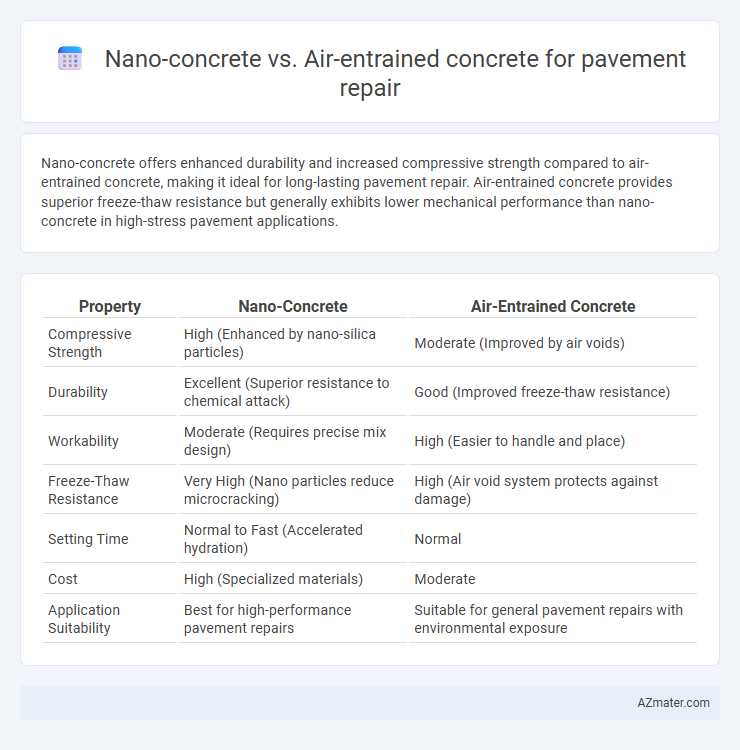Nano-concrete offers enhanced durability and increased compressive strength compared to air-entrained concrete, making it ideal for long-lasting pavement repair. Air-entrained concrete provides superior freeze-thaw resistance but generally exhibits lower mechanical performance than nano-concrete in high-stress pavement applications.
Table of Comparison
| Property | Nano-Concrete | Air-Entrained Concrete |
|---|---|---|
| Compressive Strength | High (Enhanced by nano-silica particles) | Moderate (Improved by air voids) |
| Durability | Excellent (Superior resistance to chemical attack) | Good (Improved freeze-thaw resistance) |
| Workability | Moderate (Requires precise mix design) | High (Easier to handle and place) |
| Freeze-Thaw Resistance | Very High (Nano particles reduce microcracking) | High (Air void system protects against damage) |
| Setting Time | Normal to Fast (Accelerated hydration) | Normal |
| Cost | High (Specialized materials) | Moderate |
| Application Suitability | Best for high-performance pavement repairs | Suitable for general pavement repairs with environmental exposure |
Introduction to Pavement Repair Materials
Nano-concrete incorporates nanoparticles to enhance mechanical properties and durability, making it highly suitable for pavement repair by improving crack resistance and longevity. Air-entrained concrete introduces microscopic air bubbles that increase freeze-thaw durability and reduce scaling, essential for pavements in cold climates. Selecting between nano-concrete and air-entrained concrete depends on specific repair requirements such as structural strength or environmental exposure conditions.
What is Nano-Concrete?
Nano-concrete is an advanced construction material enhanced with nanoparticles that improve the microstructure of cement composites, resulting in increased strength, durability, and resistance to environmental degradation. Unlike traditional air-entrained concrete, which incorporates microscopic air bubbles to improve freeze-thaw resistance, nano-concrete uses nanomaterials such as nanosilica or carbon nanotubes to refine pore structure and accelerate hydration processes. This technology enables faster curing times and superior mechanical performance, making nano-concrete particularly effective for long-lasting pavement repairs in demanding environmental conditions.
Understanding Air-Entrained Concrete
Air-entrained concrete is specifically designed for pavement repair by incorporating tiny air bubbles, which improve its resistance to freeze-thaw cycles and reduce the risk of cracking. This type of concrete enhances durability in cold climates by allowing water to expand safely within the air voids, preventing internal pressure damage. Compared to nano-concrete, air-entrained concrete offers improved longevity and resilience in environments subject to frequent temperature fluctuations.
Material Properties Comparison
Nano-concrete exhibits superior compressive strength and enhanced durability due to its refined microstructure and reduced porosity, making it highly effective for pavement repair under heavy traffic conditions. Air-entrained concrete, characterized by microscopic air bubbles, provides excellent freeze-thaw resistance and improved workability but typically has lower strength compared to nano-concrete. The integration of nanoparticles in nano-concrete also enhances resistance to chemical attacks and reduces shrinkage, offering longer-lasting pavement repairs than traditional air-entrained mixes.
Strength and Durability Analysis
Nano-concrete exhibits significantly higher compressive strength and enhanced durability compared to air-entrained concrete due to its refined microstructure and improved particle packing density. The incorporation of nanoparticles reduces porosity and microcracks, resulting in superior resistance to freeze-thaw cycles and chemical attacks. Air-entrained concrete provides excellent freeze-thaw durability but generally lacks the high mechanical strength and long-term resilience offered by nano-concrete in pavement repair applications.
Workability and Application Methods
Nano-concrete enhances workability through improved particle packing and reduced water demand, facilitating smoother application and faster setting times in pavement repair. Air-entrained concrete introduces microscopic air bubbles that increase freeze-thaw durability but may reduce slump and require careful mixing to maintain uniform air distribution. Application methods for nano-concrete typically involve precise dispersion techniques like ultrasonic mixing, while air-entrained concrete relies on controlled air-entrainment agents and mechanical agitation to ensure consistent performance.
Performance in Extreme Weather Conditions
Nano-concrete exhibits superior durability and enhanced resistance to extreme weather conditions compared to air-entrained concrete, due to its nano-scale additives that improve density and reduce permeability. This results in better crack control and resistance to freeze-thaw cycles, making it ideal for pavement repair in regions with severe temperature fluctuations. Air-entrained concrete provides good freeze-thaw durability but lacks the advanced microstructure refinement found in nano-concrete, limiting its long-term performance under extreme climates.
Cost-Benefit Analysis
Nano-concrete offers enhanced durability and faster curing times compared to air-entrained concrete, leading to lower long-term maintenance costs despite a higher initial investment. Air-entrained concrete provides better freeze-thaw resistance at a more affordable upfront price, making it suitable for regions with severe weather conditions. Cost-benefit analysis indicates nano-concrete is more economical for high-traffic pavement repairs due to extended service life and reduced repair frequency, while air-entrained concrete remains cost-effective for moderate traffic and budget-sensitive projects.
Environmental Impact Considerations
Nano-concrete reduces environmental impact by enhancing durability and minimizing material usage due to its improved mechanical properties and self-healing capabilities, leading to longer-lasting pavement repairs with less frequent maintenance. Air-entrained concrete, while improving freeze-thaw resistance, may involve higher cement content and air voids that can slightly compromise strength, potentially increasing resource consumption over the lifecycle of pavement repair. Selecting nano-concrete for pavement repair supports sustainability goals by lowering carbon footprint through reduced raw material demand and extending pavement service life under environmental stressors.
Choosing the Right Concrete for Pavement Repair
Nano-concrete offers enhanced durability and higher compressive strength due to its refined microstructure, making it ideal for high-stress pavement repair applications. Air-entrained concrete provides superior freeze-thaw resistance by incorporating microscopic air bubbles, which reduces cracking in cold climates. Selecting the right concrete depends on environmental conditions and load requirements, with nano-concrete preferred for heavy traffic areas and air-entrained concrete suited for regions prone to freeze-thaw cycles.

Infographic: Nano-concrete vs Air-entrained concrete for Pavement repair
 azmater.com
azmater.com